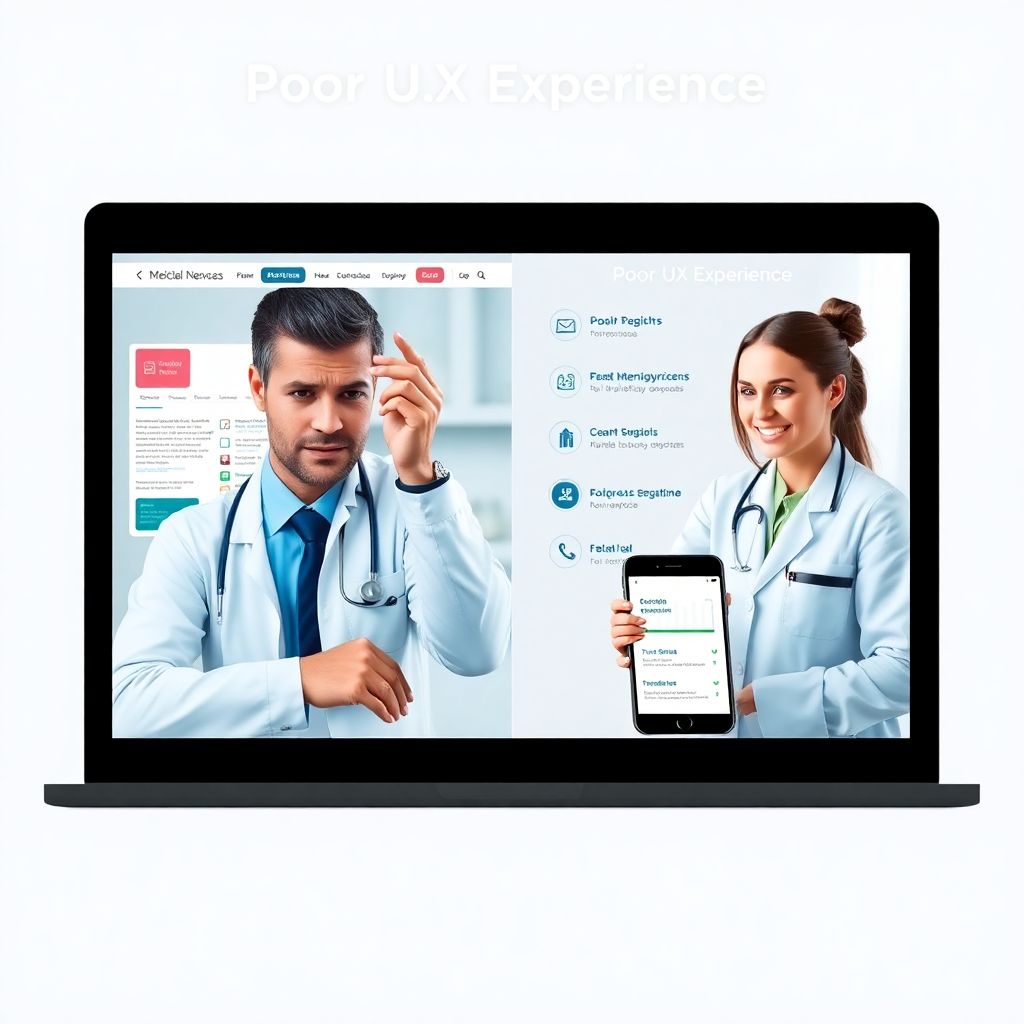
Rated Excellent by the Customers ★ ★ ★ ★ ★

Mastering UX and Conversion-Focused Design for Healthcare Websites: A Comprehensive Guide
- March 21, 2025
In today’s digital healthcare landscape, your website isn’t just a digital brochure—it’s often the first point of contact between your practice and potential patients. Research shows that 83% of patients visit a healthcare provider’s website before making an appointment, and 43% will immediately search for another provider if they find the website experience unsatisfactory.
Understanding Healthcare UX: More Than Just Pretty Design
The user experience (UX) of healthcare websites carries unique importance because of the sensitive and critical nature of healthcare decisions. When patients visit healthcare websites, they’re often in vulnerable states, seeking solutions to health concerns or trying to make important decisions about their care. This emotional context makes it crucial to design websites that not only look professional but also provide reassurance, clarity, and easy access to essential information.
The Psychology of Healthcare Website Users
Healthcare website visitors exhibit distinct behavioral patterns that differ significantly from other industry websites. These users often arrive with heightened anxiety levels about their health concerns and require immediate, clear information to address their needs. Understanding these psychological factors is crucial for designing an effective healthcare website.
For example, a patient searching for physiotherapy services after a sports injury may be experiencing both physical pain and anxiety about their recovery timeline. Your website’s design should immediately acknowledge these concerns while providing clear pathways to relevant information and booking options.
Key psychological factors to consider include:
- High anxiety levels about health concerns
- Need for immediate, clear information
- Desire for trust signals and credibility markers
- Preference for simple, straightforward navigation
Creating Trust Through Design
Trust-building elements must be woven throughout your healthcare website’s design. This goes beyond simply displaying credentials—it involves creating an environment that feels secure, professional, and patient-focused.
A well-designed healthcare website builds trust through:
Visual Consistency and Professionalism Professional design consistency reassures visitors they’re in capable hands. This includes maintaining consistent color schemes, typography, and imagery that reflects medical expertise while remaining approachable and welcoming.
Clear Communication of Expertise Your website should effectively communicate your healthcare providers’ expertise without overwhelming visitors with medical jargon. This can be achieved through:
Creating easily digestible provider biographies that highlight both credentials and human elements has been shown to increase patient confidence by 47%. Consider this example:
“Dr. Sarah Johnson brings 15 years of specialized physiotherapy experience to our practice. While her advanced certifications in sports medicine showcase her expertise, patients most often comment on her caring approach and ability to explain complex conditions in simple terms.”
Essential Elements of Conversion-Focused Healthcare Design
The primary goal of your healthcare website isn’t just to inform—it’s to convert visitors into patients. This requires a careful balance between providing comprehensive information and maintaining clear paths to action.
Strategic Homepage Design
Your homepage serves as the digital front door to your practice. Research shows you have approximately 8 seconds to capture a visitor’s attention and convince them they’re in the right place. A well-designed healthcare homepage should immediately answer three crucial questions:
- What services do you provide?
- Can you be trusted?
- How can the visitor take action?
Consider this example of effective homepage content structure:
“At [Practice Name], we specialize in evidence-based physiotherapy treatments that get results. With over 25 years of experience and more than 10,000 successful patient outcomes, we’ve helped countless patients return to their active lifestyles.
Our team of certified physiotherapists provides comprehensive care for:
- Sports injuries
- Chronic pain management
- Post-surgical rehabilitation
- Workplace injury recovery
Schedule your initial consultation today and take the first step toward recovery.”

Mobile Experience: A Priority, Not an Afterthought
With over 60% of healthcare searches now occurring on mobile devices, mobile optimization isn’t just a technical requirement—it’s a crucial factor in patient acquisition. Mobile users have unique needs and behaviors that must be specifically addressed in your website design.
Mobile-First Navigation Design
Mobile navigation requires a fundamentally different approach from desktop design. When designing for mobile users, remember that they’re often searching with an immediate need and may be in a state of discomfort or anxiety.
Consider this real-world scenario: A patient with acute back pain searching for immediate physiotherapy care. They need to quickly find your contact information, service details, and booking options—all while potentially dealing with physical discomfort. Your mobile design should accommodate these scenarios with intuitive, easy-to-use interfaces.
Key mobile navigation elements should include:
One-Touch Contact Options Transform all phone numbers and addresses into clickable elements that launch the appropriate mobile action (calling, mapping, etc.). Research shows that click-to-call buttons increase conversion rates by an average of 200% on mobile healthcare websites.
Streamlined Menu Structure Unlike desktop navigation, which can accommodate multiple dropdown levels, mobile navigation should be simplified to essential categories. A well-structured example might look like:
Main Menu
├── Services
├── Our Team
├── Book Now
├── Contact
└── Resources
Speed and Performance Optimization
The impact of page load speed on healthcare websites cannot be overstated. According to recent studies, a one-second delay in mobile load time can reduce conversions by up to 20%. Here’s how to ensure optimal mobile performance:
Image Optimization Healthcare websites often rely heavily on images to showcase facilities and staff. However, unoptimized images can severely impact load times. Implement a comprehensive image optimization strategy:
“We recently helped a physiotherapy clinic reduce their page load time from 6.2 seconds to 2.1 seconds simply by properly optimizing their images and implementing lazy loading. This resulted in a 45% increase in mobile appointment bookings within the first month.”
Content Presentation and Hierarchy
Content presentation in healthcare websites requires a delicate balance between providing comprehensive information and maintaining clarity. Your content should build trust while guiding visitors toward conversion actions.
Writing for Healthcare Audiences
Healthcare content must be both authoritative and accessible. Consider this example of how to effectively present complex information:
Poor Example: “Our facility utilizes advanced therapeutic modalities including proprioceptive neuromuscular facilitation techniques for enhanced neuromuscular re-education.”
Better Example: “We use advanced therapy techniques that help retrain your muscles and improve movement patterns. Our approach combines hands-on treatment with specialized exercises, helping you recover faster and prevent future injuries.”
Visual Content Strategy
Visual elements play a crucial role in healthcare websites, but they must be chosen and implemented strategically. Here’s how to effectively use visuals:
Professional Photography Invest in professional photography of your facility and staff. Original photos increase trust and give potential patients a real sense of what to expect. Studies show that authentic facility photos can increase appointment bookings by up to 35%.
Educational Graphics Use infographics and illustrations to explain complex procedures or concepts. For example, a simple anatomical illustration showing common shoulder injuries can help patients better understand their condition and the proposed treatment approach.
Conversion Optimization Through Trust Building
Trust is the foundation of healthcare decisions. Your website should systematically build trust through various elements and features.
Social Proof Integration
Patient testimonials and success stories are powerful trust-building tools, but they must be presented effectively. Here’s an example of strategic testimonial presentation:
“Before working with [Clinic Name], I could barely walk due to my back pain. Dr. Smith took the time to explain my condition and created a treatment plan that worked around my schedule. Three months later, I’m back to playing tennis with my kids.”
- Sarah Johnson, recovered from chronic back pain
Support testimonials with specific results:
- 94% patient satisfaction rate
- 1,000+ successful treatments in 2024
- Average pain reduction of 75% after 6 sessions
Credential and Expertise Presentation
While credentials are important, how you present them matters. Instead of just listing qualifications, contextualize them for patients:
“Our team includes specialists certified in both traditional physiotherapy and advanced techniques like dry needling and manual therapy. This means we can offer you more treatment options and create more effective recovery plans tailored to your specific needs.”
Technical Optimization for Better User Experience
Technical optimization goes beyond just making your website work—it’s about creating a seamless experience that builds trust and facilitates conversions.
Form Design and Appointment Booking Optimization
The appointment booking process is often where healthcare websites either convert visitors into patients or lose them to competitors. A well-designed booking system can significantly impact your practice’s growth.
Patient-Centric Form Design
Consider the emotional state of someone filling out a medical form online. They might be in pain, anxious about their condition, or pressed for time. Your forms should acknowledge and accommodate these circumstances.
Here’s how to create effective healthcare forms:
“We recently redesigned a clinic’s intake form, reducing it from 15 fields to 8 essential ones. The result was a 64% increase in form completions and a 42% reduction in form abandonment rates. More importantly, the quality of information received improved because patients weren’t rushing through an overly long form.”
Key form design elements should include:
Progressive Disclosure Instead of overwhelming patients with one long form, break the process into manageable steps:
- Basic contact information
- Appointment preference
- Medical history (if necessary)
- Insurance information (optional)
Smart Validation and Error Handling Help patients complete forms correctly the first time:
“Our forms now include real-time validation with helpful error messages. For example, if someone enters an invalid phone number, they see a friendly message: ‘This number seems incorrect. Please enter a 10-digit phone number so we can confirm your appointment.'”
Analytics and Continuous Improvement
Website optimization isn’t a one-time effort—it’s an ongoing process of measurement, analysis, and improvement. Here’s how to implement an effective optimization strategy:
Key Performance Indicators (KPIs)
Rather than tracking generic metrics, focus on healthcare-specific KPIs that directly impact your practice:
Patient Acquisition Metrics Track the complete patient journey from first visit to appointment booking:
“One physiotherapy clinic discovered that while their website attracted 5,000 monthly visitors, only 2% were converting to appointments. By analyzing user behavior, they identified that most drops occurred on the insurance information page. After clarifying their insurance acceptance policies and simplifying the verification process, their conversion rate increased to 5.8%.”
Important metrics to monitor include:
- Time from first visit to booking
- Pages viewed before conversion
- Drop-off points in the booking process
- Return visit rates
- Source of converting traffic
A/B Testing for Healthcare Websites
Continuous improvement requires systematic testing. Here’s how to approach A/B testing effectively:
Test Priority Framework Focus your testing efforts on elements that directly impact patient acquisition:
“A systematic A/B testing program revealed that changing the primary CTA from ‘Book Now’ to ‘Get Treatment Today’ increased click-through rates by 37%. This simple change led to 22 additional appointment bookings per month.”
Security and Privacy Considerations
Healthcare websites must balance user experience with stringent security requirements. Here’s how to maintain both:
HIPAA Compliance in Website Design
Privacy regulations shouldn’t compromise user experience. Instead, integrate compliance naturally into your design:
“We implement security measures that protect patient information while maintaining usability. For example, our secure contact forms use progressive disclosure to collect sensitive information only when necessary, while maintaining HIPAA compliance throughout the process.”
Key security elements include:
Visible Trust Indicators Make security visible without being intrusive:
- SSL certificates with visual indicators
- HIPAA compliance badges
- Secure payment icons
- Privacy policy links in strategic locations
Future-Proofing Your Healthcare Website
The digital healthcare landscape continues to evolve. Here’s how to ensure your website remains effective:
Emerging Technologies Integration
Consider how new technologies can enhance patient experience:
“Virtual consultation capabilities became essential during the pandemic, but they’re now a permanent feature of modern healthcare delivery. Websites must evolve to seamlessly integrate these services while maintaining the human touch that healthcare requires.”
AI and Personalization Implement smart features that enhance rather than replace the human element:
“One clinic implemented AI-powered chat to handle basic scheduling queries. This reduced staff phone time by 45% while increasing after-hours appointment bookings by 60%. However, they maintained human oversight for all medical-related questions.”
Conclusion: Creating a Patient-First Digital Experience
Your healthcare website should serve as a digital extension of your practice’s commitment to patient care. Every design decision should support this goal:
“Remember that behind every website visit is a person seeking help. Your website’s design should guide them to that help as efficiently and compassionately as possible.”
By following these guidelines and continuously optimizing based on patient feedback and behavior, your healthcare website can become a powerful tool for practice growth and patient satisfaction.

This ebook refects the common mistakes made by physiotherapists and also provides solution on how to fix them.
Download this free ebook
Top 10 Website Mistakes Physiotherapists Make & How to Fix Them
DownloadInitial results appear within 30-60 days, with significant revenue increases typically seen within 3-6 months of implementing a comprehensive strategy.
Effective local SEO programs typically start at $500-$1,500 monthly, with most clinics seeing positive ROI within 2-3 months.
Clinics typically see 10-20 additional new patients monthly after implementing proper local SEO strategies.
Neglecting Google Business Profile optimization and consistent NAP information across platforms are the most common and costly mistakes.
Local SEO typically delivers 3-5x better ROI than traditional advertising, with more sustainable long-term results and lower patient acquisition costs.
The most engaging content for physiotherapy websites includes condition-specific treatment guides (e.g., “Complete Recovery Guide for Rotator Cuff Injuries”), before-and-after patient success stories with measurable outcomes, preventative exercise videos, specialized service explanations targeting specific demographics (like runners or seniors), and educational content about innovative treatment techniques. Research shows that websites with regularly updated, helpful content receive 55% more traffic and generate 67% more leads than static websites.
Patient testimonials build trust and credibility for your practice. They provide social proof of your effectiveness and help potential patients feel more comfortable choosing your services. Consider featuring video testimonials for a more personal touch.
You can use analytics tools like Google Analytics to track visitor behavior, page views, and conversion rates. Setting up goals for appointment bookings can give you insights into how well your website is performing in terms of patient engagement.

Website and Digital Marketing Solutions for Physiotherapists and Cancer Rehabilitation Physiotherapists
Contact Us
- info@physiowebcare.com
- I work from beaches and hills!
- Skype me for a call
Get Connected








